Under a new flag: the second life of the Do 335B-2 "M14"!
Two models, one and the same aircraft! The Do 335B-2 “M14”
In a previous article, I already dealt with the Do 335 M14, serial number 230014: as a prototype of the planned "destroyer" version, this aircraft is of particular interest to aircraft enthusiasts. The model in this article shows the M14 with the registration RP+UQ in the appearance in which it was flown until spring 1945. The following article will deal with the exciting history of this aircraft in the years from the end of the war to 1949. The dates already give a hint: for a Do 335, the M14 had an unusually long and probably also eventful "life"!
On 27 April, the advancing French troops were able to seize the M14 along with numerous other Do 335s near Mengen airfield. In contrast to the vast majority of Do 335s found in various states of construction and completion, this particular one was not waiting for the cutting torch: the fully equipped and intact aircraft - the attempt to blow it up with a bomb on 22 April had failed - was designated by the victors as part of the French share of the booty. Incidentally, the French also took over the identically constructed M13 / serial number 230013. Thus both prototypes of the planned "destroyer" version were in French hands.
However, it was to take some time before the M14 began flight testing: in June and July 45, the aircraft was first overhauled, repainted and the equipment was completed with loot parts. At the end of July 45, the aircraft was transported by road to the Centre d'Essais en Vol (CEV) in Bretigny, France, where it was finally put into service as Do 335 "No.1".
However, the first flight on 8 August threatened to be the last: Pilot Colonel Paul Badre first got into trouble during the landing approach due to the failure of the nose engine, whereby the second engine in the tail was also crippled during the attempt to restart the engine. Badre still managed a hard landing on the Lyon-Bron airfield, but the taxiing M14 rammed a parked B-26 and was badly damaged. It turned out that the Dornier needed a completely new nose engine and a new right landing gear leg; furthermore, the lower tail fin and the right wing had to be repaired. The restoration took place at SNCASO in Suresnes and was to last until June 1946.
In the months that followed, the M14 was tested extensively on the ground. In February 1947, the three MK 103s were installed - with water ballast instead of ammunition - and flight tests were resumed. However, a fire in the brakes and tyres meant that the M14 did not take to the air until 13 March.
During the first speed measurement flight on 25 April, an impressive 700 km/h were flown at an altitude of 1500 metres. This was followed by intensive flight testing from May of the following year; a total of nine flight hours were accumulated during this time. The pilot of the fast aircraft was usually Captain Receveau, a former fighter pilot and now a test pilot for the CEV.
Even though interest in the Do-335 began to wane at the end of the 1940s against the background of the new jet engine, and the official test programme of the M14 was terminated in the spring of 1948, this did not mean the end of its flying career: until January 49, further flights were added, so that the total flying time of this aircraft finally added up to 11 hours and 25 minutes. This makes the M14 one of the most intensively flown Do-335s. Soon after January 1949, however, traces of the M14 disappear, and in the early 1950s the aircraft was probably scrapped in France.
About the building process:
Tamiya's excellent kit was actually not changed at all this time, because for the usual places where post-detailing likes to be done- I'm thinking here of the cockpit and the open landing gear areas- I had special plans for this project!
For one of the three aircraft that I would create from the high quality parts, I really wanted to try a representation in fast flight. I was motivated by the fact that a flying Do-335 is not often seen in original pictures and even less so as a model. On the other hand, the elongated and powerful lines of a 335 "Arrow" would certainly look even sleeker without the powerful landing gear!
In order to realise this project, it was of course necessary to close the multi-part fairing of the three undercarriage areas. Thanks to the excellent dimensional accuracy of the parts, this was not a big problem. However, it should be noted that it also became clear that the kit parts were not designed for display with the landing gear retracted. Some structures had to be trimmed with a scalpel to achieve a seamless closure of the three landing gear bays.
A second prerequisite for the flight display is a pilot in the cockpit. Because of the fineness of the details and the well-made structures I decided to use a former Spitfire pilot from the leftover box. However, something had to be modified here: a Do-335 pilot wears an oxygen mask on the one hand - this was improvised with some Fimo and a handful of fine etched parts and wire - on the other hand he does not need a life jacket. This was not a difficult part either, because after trimming it with a knife, the large turned-up collar of a pilot's jacket could be modelled, again with Fimo. Fine strands of cable to represent the headphone wiring, together with a little colour, completed the representation of the French pilot.
The third necessity for depicting a propeller machine in flight is -last but not least- rotating propellers. These were indicated with a meanwhile well-tried approach: transparent film was treated with a touch of the propeller colour along the length of a propeller blade, whereby the maxim clearly applies: less is more! In the direction of the propeller grain, the darkness or density of the paint application thickens in a slight wedge shape. Only then should the contours of a turning propeller be cut out; this has the advantage that no paint mist can reach the narrow side edge of the film. This is important because this edge must appear as transparent as possible so that the contour of the film visually dissolves.
It should also be noted that the openings in the two spinners, which are incorporated for the wide base of the propellers, are carefully filled. Visible openings would of course quickly destroy the illusion of spinning propellers.
I think the representation of spinning propellers on a stationary model is in itself an impossibility, so any attempt to deal with it is valid. It can only be an approximation that relies on the imagination and fantasy of the viewer.
To conclude my remarks on the "flying" Do-335B M14, I would like to immediately reinforce this basically quite pleasing thought: isn't it precisely this circumstance that there will never be the one final "perfection", but always only the most successful, creative, design solutions possible, which above all must satisfy the designer himself, that is actually the beauty of model building?
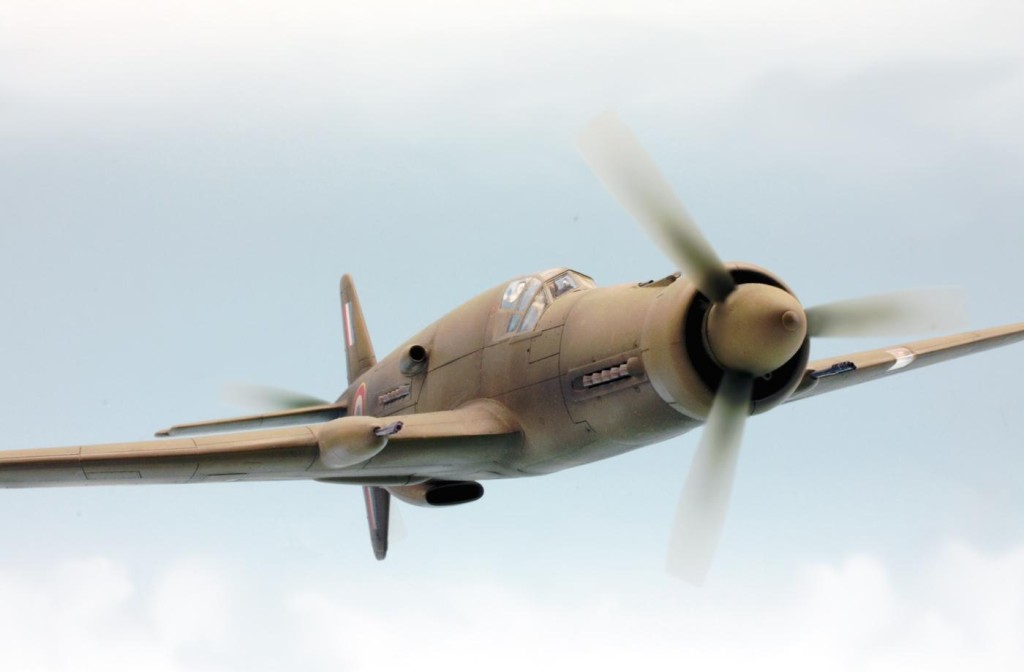
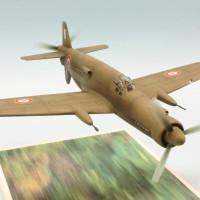
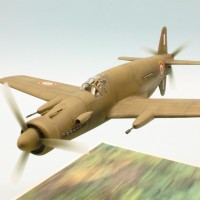
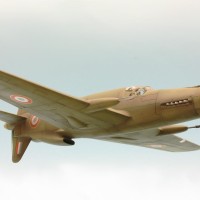



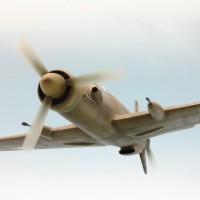

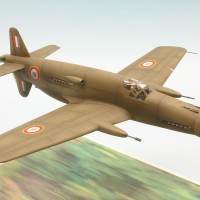
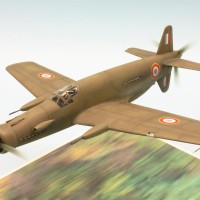
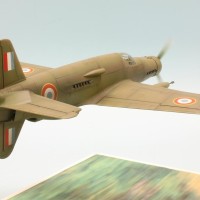
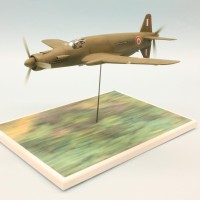
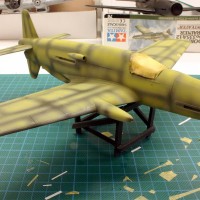
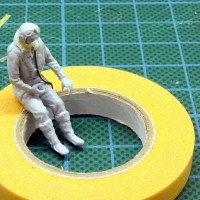
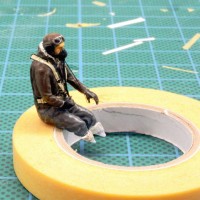
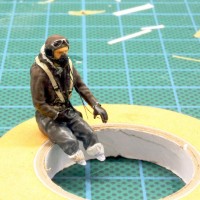
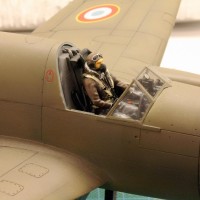
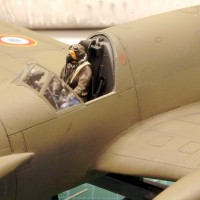
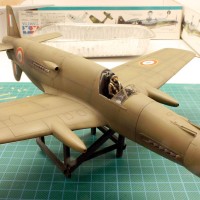
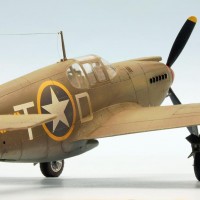
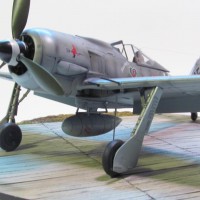

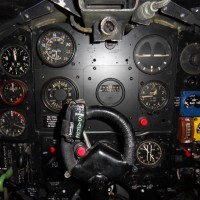
What an amazing build, Roland @rosachsenhofer
The way you presented it in-flight is superb.
Did you create the spinning propeller effect with painting?
Thank you John, your words make me very happy!
Yes, the light-dark distribution is "breathed on" with the airbrush. I'll show you a few photos of these "spinning propellers" in progress to give you a better idea. The pictures are from another "flying" project -a Bf 108- but the execution is exactly the same.
1 attached image. Click to enlarge.
Truly wonderful build, presentation and accompanying article, Roland!
Always a joy to read your reviews!
Thank you, my friend, for the motivating words!
The whole model is really nice, as is all your work, @rosachsenhofer, but the pilot figure is really superb. You did the face so well I at first thought you were "having us on" by photoshopping a real face.
Thank you Tom: I have to admit, the painting of this figure surprised me myself; a few things went quite happily here. What I found confirmed again: the eye area only needs a hint of colour!
Makes me sick to look at the speed effects...so it must mean my brain think it is for real 🙂
The Dornier 335 would be interesting as a pylon racing machine, anyone?
Thank you Stellan! 🙂
Indeed- what a "what if" idea for another Do-335 project!
Well done, Roland (@rosachsenhofer). The work have done to produce an "inflight" model is truly amazing.
Thank you for your words of appreciation, I'm glad!
Beautiful build and awesome display, Roland, @rosachsenhofer. I really like the way you get the rotating prop effect. It is the best I have seen for a static display. Really excellent!
Your words make me very happy - and proud 🙂 Thanks!
Well shoot - I need to buy about 2000 1/72 propellers from you to retro-fit all my prop builds! That technique is fantastic! I wouldn't do it myself just because all that extra work would bog down all my prop builds, since they are all in-flight. And I already feel like a turtle in getting mine off the bench! Beautiful project, and I ditto Tom's comments about the pilot - fantastic work all the way around. Superb!
Greg, give me some time, but 2000 should be doable... No, seriously, your words make me very happy and I feel really motivated; thank you very much for this encouragement!
Awesome! the Diorama is great and really gives one a sense of speed.
Thank you, males me feel motivated!
Once again, superb! Love seeing the Pfiel in flight... looks very sleek.
Thank you alot, Doug, appreciated!